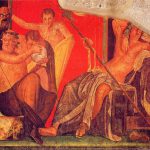Luna (“the Moon”) was the Roman goddess of the moon; equated with the Greek Selene. Often Luna was depicted as the female complement to the god Sol (“the Sun”). Luna is also depicted as one of the three goddesses (diva triformis) alongside Proserpine and Hecate.
Originally she was a Sabine deity. Bringing her cult to Rome (along with the cult of Sol) was ascribed to Titus Tatius. Previously, she was identified with the Italian and Roman Diana.
Several temples were erected for her, the most important of which was on Aventine Hill. At her sanctuary on Palatine Hill (where she was worshipped as Noctiluca – “Shining by Night”), a light was lit in her honour every evening.
In the art of ancient Rome, she was most often depicted on the model of the Greek Selene, that is, in a luminous garment, with a crescent moon, on a chariot drawn by two horses or oxen (biga). Apart from Luna, the god Sun rode the chariot. Sol sat in a four-horse chariot (quadriga) for a change.







